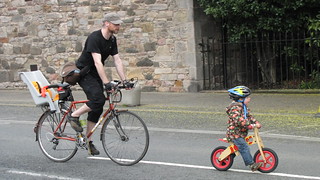Louise Shaw is the engineer working for Scotrail/Transport Scotland on drafting the specifications & supplier options for the new train fleet to replace the Class 15x fleets (156, 158, plus a few 153 & 150, diesel trains and the replacements for Class 318 and 320 electric trains, that soldier on for some SPT area (old Blue Train routes from 1960 - Class 303/305)
The diesel trains will be replaced by hybrid units that can run with electric traction, and use a 'module' that contains a battery pack, or diesel electric 'package', and may be similar to the 'articulated' half-trains already being used in Liverpool, East Anglia and Newcastle. These trains have full width connections through the carriages, and save weight by having one bogie between 2 carriages. I suspect that this might also see all trains having the same standard coupling (Dellner 10) and set up for 100mph maximum speed, and performance to match all the modern Scotrail units, which improves the ability to harmonise the services all using the same tracks with same performance (the old trains have 75/90 mph top speeds, & 2 (3 with HST's) different types of coupling!)
One proven candidate is the Stadler FLIRT series which is already with several operators as a central diesel or a battery module connected to outer modules which can operate as pure electric trains with the centre unit removed
The Stadler trains also have floor heights dropped to match platform heights (915mm), whilst other suppliers still build to the old standard (1100mm. The Hitachi bodyshell design also builds in a 2" step at every external door for the Class 80x (LNER, Lumo, TPE and now also Avanti) plus the Scotrail Class 385, there also remains the bogie yaw issue which saw the new trains having fractures in yaw damper brackets through an embedded resonant oscillation issue
The trains built for Liverpool also use a version of the cycle stowage (a design I first noted in 1988) which fits 3 bikes into the space released by removing a pair of fixed seats, plus cutting back the draught screen at the sliding doors. By neatly angling the front wheels 3 bikes fit in the same space as most trains allow for just 2
Hopefully we'll see the experience of Merseyrail and Greater Anglia's newest trains being used for the Scotrail ones, with the 'standard' that I pressed for with the Class 380 and Class 385 trans, that has also been retro-fitted on HST (Coach C) plus the Class 334 (refurbishment) with a cycle space at least 2.4 metres long (5 tip-up seats), which can easily accommodate tandems, long-tails, recumbents and trikes
A good topic to raise with MSP's as this decision is being made by Transport Scotland for Scotrail
PM me for any further news
It would be a useful detail to finally move the cycle & wheelchair space reservations, and availability away from the bodge we've been using since 1978 (using the seat reservation system) to a data file that interfaces with the core 'Open Rail Data' (AKA TRUST) that shows all trains running on the network, and the developer Tom Cairns has already connected a data file showing the carriage details (numbers, types etc) on his RealTimeTrains app for most Scotrail trains
The same could be done for cycle spaces but it will have some costs & time to test & develop, if there are any computer-literate geeks out there?

 posts
posts
